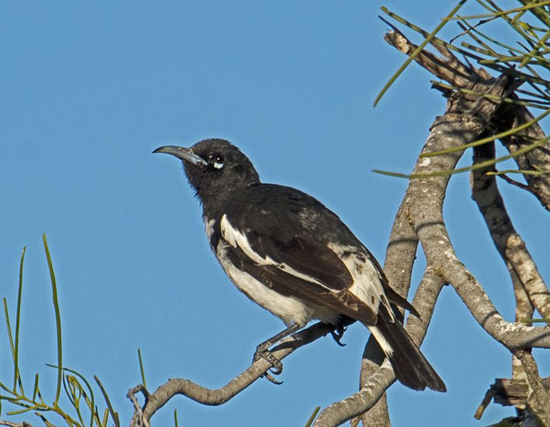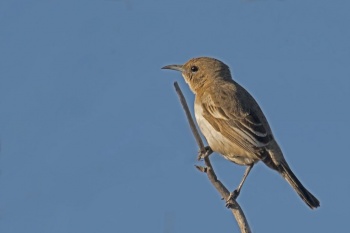- Certhionyx variegatus
Identification
15–20 cm (6-7¾ in)
- Long curved bill
- Blue eye patch; less conspicuous in females
Male
- Black head, neck and upperparts
- White lower rump and upper tail
- Black wings with white stripe
- Black-tipped tail
Female: brown upperparts, greyish-white chin, white breast
Distribution
Australia: found in arid central Australia, to coasts in central Western Australia
Taxonomy
This is a monotypic species[1].
Habitat
Mainly arid shrublands, woodlands, sandhills, inland ranges and granite outcrops.
Behaviour
Diet
Diet consists mostly of nectar, but they also eat insects, and occasionally fruit and seeds. The long bill is used to probe into flowers.
They feed with Black Honeyeaters, White-fronted Honeyeaters and Woodswallows.
Breeding
The shallow cup shaped nest is constructed from twigs, grass and spiders' webs, then lined with grass, roots, wool, and feathers. Both adults build the nest, incubate and feed the young.
References
- Clements, J. F., T. S. Schulenberg, M. J. Iliff, D. Roberson, T. A. Fredericks, B. L. Sullivan, and C. L. Wood. 2016. The eBird/Clements checklist of birds of the world: v2016, with updates to August 2016. Downloaded from http://www.birds.cornell.edu/clementschecklist/download/
- Handbook of the Birds of the World Alive (retrieved November 2016)
- Birds in Bakyards
Recommended Citation
- BirdForum Opus contributors. (2024) Pied Honeyeater. In: BirdForum, the forum for wild birds and birding. Retrieved 28 April 2024 from https://www.birdforum.net/opus/Pied_Honeyeater
External Links
GSearch checked for 2020 platform.1






